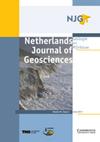The benthic foraminiferal response to the mid-Maastrichtian event in the NW-European chalk sea of the Maastrichtian type area
IF 2.3
2区 地球科学
Q3 GEOSCIENCES, MULTIDISCIPLINARY
Netherlands Journal of Geosciences-Geologie En Mijnbouw
Pub Date : 2022-06-08
DOI:10.1017/njg.2022.10
引用次数: 2
Abstract
Abstract The mid-Maastrichtian carbon isotope event (MME), dated at ∼69 Ma, reflects a perturbation of the global carbon cycle that, in part, correlates with the enigmatic global extinction of ‘true’ (i.e., non-tegulated) inoceramid bivalves. The mechanisms of this extinction event are still debated. While both the inoceramid extirpation and MME have been recorded in a variety of deep-sea sites, little is known about their expression in epicontinental chalk seas. In order to study the shallow-marine signature of the MME in this epicontinental shelf sea, we have generated quantitative foraminiferal assemblage data for two quarries (Hallembaye, NE Belgium; ENCI, SE Netherlands) in the Maastrichtian type area, complemented by a species-specific benthic δ13C record. In contrast to deep-sea records, no significant changes in benthic foraminiferal assemblages and benthic foraminiferal accumulation rates are observed across the MME in the type-Maastrichtian area. At the Hallembaye quarry, the otherwise rare endobenthic species Cuneus trigona reaches a transient peak abundance of 33.3% at the onset of the MME, likely caused by a local transient change in organic matter flux to the seafloor. Nevertheless, high and near-constant species evenness shows that neither oxygen nor organic matter flux was limited across the extinction level or during the MME. Benthic foraminiferal data from the uppermost part of the studied section, above the MME, indicate a significant increase in food supply to the seafloor. Decreased amounts of terrigenous elements across this interval document a lesser riverine or aeolian influx, which means that the increased benthic productivity is linked to a different origin. Potentially, the continuous precipitation of chalk under nutrient-poor conditions in the Late Cretaceous chalk sea was enabled by efficient nutrient recycling in the water column. In shallower depositional settings, nutrient recycling took place closer to the seafloor, which allowed more organic matter to reach the bottom. These results provide insights in the importance of nutrient cycling for biological productivity in the NW-European chalk sea.马斯特里赫特类型区西北欧白垩海底栖有孔虫对中马斯特里赫特事件的响应
马斯特里赫特中部碳同位素事件(MME)的年代为~ 69 Ma,反映了全球碳循环的扰动,这在一定程度上与“真正的”(即非受调节的)双壳类生物的神秘全球灭绝有关。这次灭绝事件的机制仍在争论中。虽然在各种深海地点都记录了疫苗灭绝和MME,但对它们在陆表白垩海中的表现知之甚少。为了研究陆表陆架海MME的浅海特征,我们对两个采石场(比利时东北部halllembaye;eni, SE Netherlands)在Maastrichtian型区域,辅以物种特有的底栖动物δ13C记录。与深海记录相比,在马斯特里赫特类型区域的MME中,底栖有孔虫组合和底栖有孔虫积累速率没有显著变化。在Hallembaye采石场,其他稀有的底栖物种三角鱼Cuneus trigona在MME开始时达到了33.3%的短暂丰度峰值,这可能是由局部的海底有机质通量短暂变化引起的。然而,高的和接近恒定的物种均匀性表明,在整个灭绝水平或在MME期间,氧气和有机质通量都没有受到限制。来自研究剖面最上方(MME上方)的底栖有孔虫数据表明,海底食物供应显著增加。这段时间内陆源元素的减少表明河流或风吹物的流入较少,这意味着底栖生物生产力的增加与不同的来源有关。可能的是,在晚白垩世白垩海中,在营养贫乏的条件下,白垩的持续降水是由水柱中有效的营养循环实现的。在较浅的沉积环境中,营养物质的循环发生在靠近海底的地方,这使得更多的有机物能够到达海底。这些结果提供了养分循环对西北欧洲白垩海生物生产力的重要性的见解。
本文章由计算机程序翻译,如有差异,请以英文原文为准。
求助全文
约1分钟内获得全文
求助全文
来源期刊
CiteScore
4.00
自引率
25.90%
发文量
14
审稿时长
>12 weeks
期刊介绍:
Netherlands Journal of Geosciences - Geologie en Mijnbouw is a fully open access journal which publishes papers on all aspects of geoscience, providing they are of international interest and quality. As the official publication of the ''Netherlands Journal of Geosciences'' Foundation the journal publishes new and significant research in geosciences with a regional focus on the Netherlands, the North Sea region and relevant adjacent areas. A wide range of topics within the geosciences are covered in the journal, including "geology, physical geography, geophyics, (geo-)archeology, paleontology, hydro(geo)logy, hydrocarbon exploration, modelling and visualisation."
The journal is a continuation of Geologie and Mijnbouw (published by the Royal Geological and Mining Society of the Netherlands, KNGMG) and Mededelingen Nederlands Instituut voor Toegepaste Geowetenschappen (published by TNO Geological Survey of the Netherlands). The journal is published in full colour.

 求助内容:
求助内容: 应助结果提醒方式:
应助结果提醒方式:


